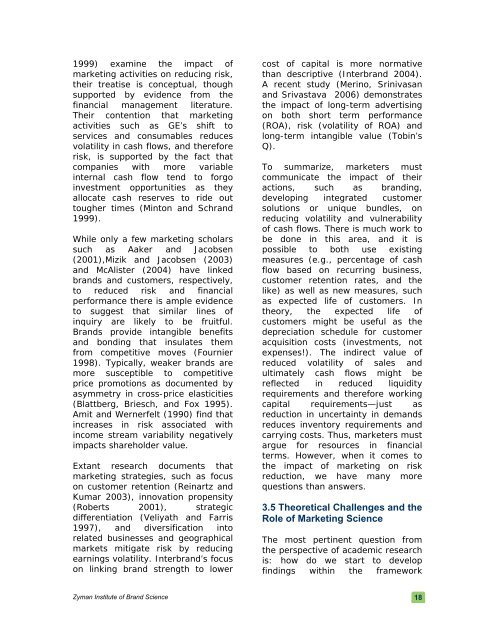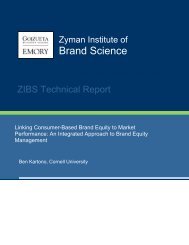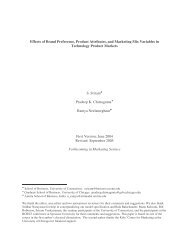Linking Marketing Metrics to Financial Performance - Emory ...
Linking Marketing Metrics to Financial Performance - Emory ...
Linking Marketing Metrics to Financial Performance - Emory ...
You also want an ePaper? Increase the reach of your titles
YUMPU automatically turns print PDFs into web optimized ePapers that Google loves.
1999) examine the impact ofmarketing activities on reducing risk,their treatise is conceptual, thoughsupported by evidence from thefinancial management literature.Their contention that marketingactivities such as GE’s shift <strong>to</strong>services and consumables reducesvolatility in cash flows, and thereforerisk, is supported by the fact thatcompanies with more variableinternal cash flow tend <strong>to</strong> forgoinvestment opportunities as theyallocate cash reserves <strong>to</strong> ride out<strong>to</strong>ugher times (Min<strong>to</strong>n and Schrand1999).While only a few marketing scholarssuch as Aaker and Jacobsen(2001),Mizik and Jacobsen (2003)and McAlister (2004) have linkedbrands and cus<strong>to</strong>mers, respectively,<strong>to</strong> reduced risk and financialperformance there is ample evidence<strong>to</strong> suggest that similar lines ofinquiry are likely <strong>to</strong> be fruitful.Brands provide intangible benefitsand bonding that insulates themfrom competitive moves (Fournier1998). Typically, weaker brands aremore susceptible <strong>to</strong> competitiveprice promotions as documented byasymmetry in cross-price elasticities(Blattberg, Briesch, and Fox 1995).Amit and Wernerfelt (1990) find thatincreases in risk associated withincome stream variability negativelyimpacts shareholder value.Extant research documents thatmarketing strategies, such as focuson cus<strong>to</strong>mer retention (Reinartz andKumar 2003), innovation propensity(Roberts 2001), strategicdifferentiation (Veliyath and Farris1997), and diversification in<strong>to</strong>related businesses and geographicalmarkets mitigate risk by reducingearnings volatility. Interbrand’s focuson linking brand strength <strong>to</strong> lowercost of capital is more normativethan descriptive (Interbrand 2004).A recent study (Merino, Srinivasanand Srivastava 2006) demonstratesthe impact of long-term advertisingon both short term performance(ROA), risk (volatility of ROA) andlong-term intangible value (Tobin’sQ).To summarize, marketers mustcommunicate the impact of theiractions, such as branding,developing integrated cus<strong>to</strong>mersolutions or unique bundles, onreducing volatility and vulnerabilityof cash flows. There is much work <strong>to</strong>be done in this area, and it ispossible <strong>to</strong> both use existingmeasures (e.g., percentage of cashflow based on recurring business,cus<strong>to</strong>mer retention rates, and thelike) as well as new measures, suchas expected life of cus<strong>to</strong>mers. Intheory, the expected life ofcus<strong>to</strong>mers might be useful as thedepreciation schedule for cus<strong>to</strong>meracquisition costs (investments, notexpenses!). The indirect value ofreduced volatility of sales andultimately cash flows might bereflected in reduced liquidityrequirements and therefore workingcapital requirements—just asreduction in uncertainty in demandsreduces inven<strong>to</strong>ry requirements andcarrying costs. Thus, marketers mustargue for resources in financialterms. However, when it comes <strong>to</strong>the impact of marketing on riskreduction, we have many morequestions than answers.3.5 Theoretical Challenges and theRole of <strong>Marketing</strong> ScienceThe most pertinent question fromthe perspective of academic researchis: how do we start <strong>to</strong> developfindings within the frameworkZyman Institute of Brand Science 18





